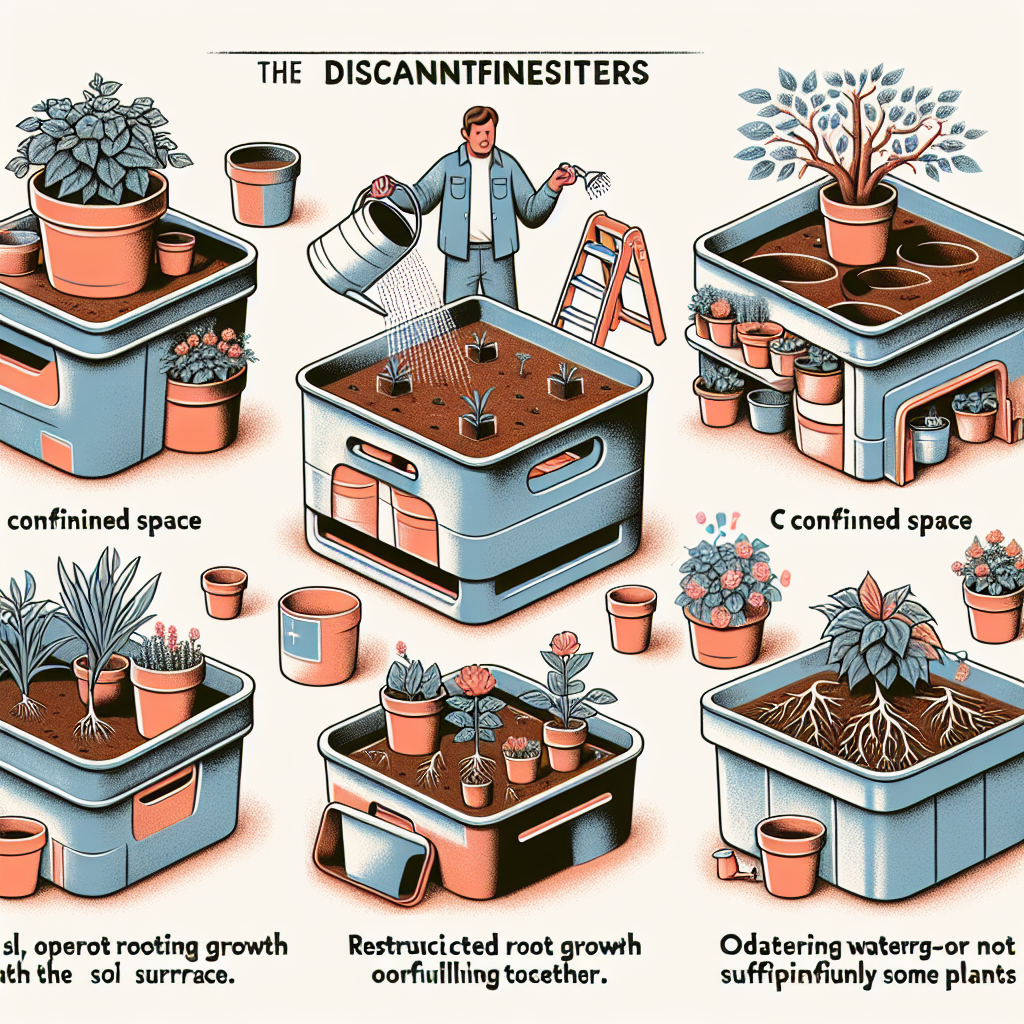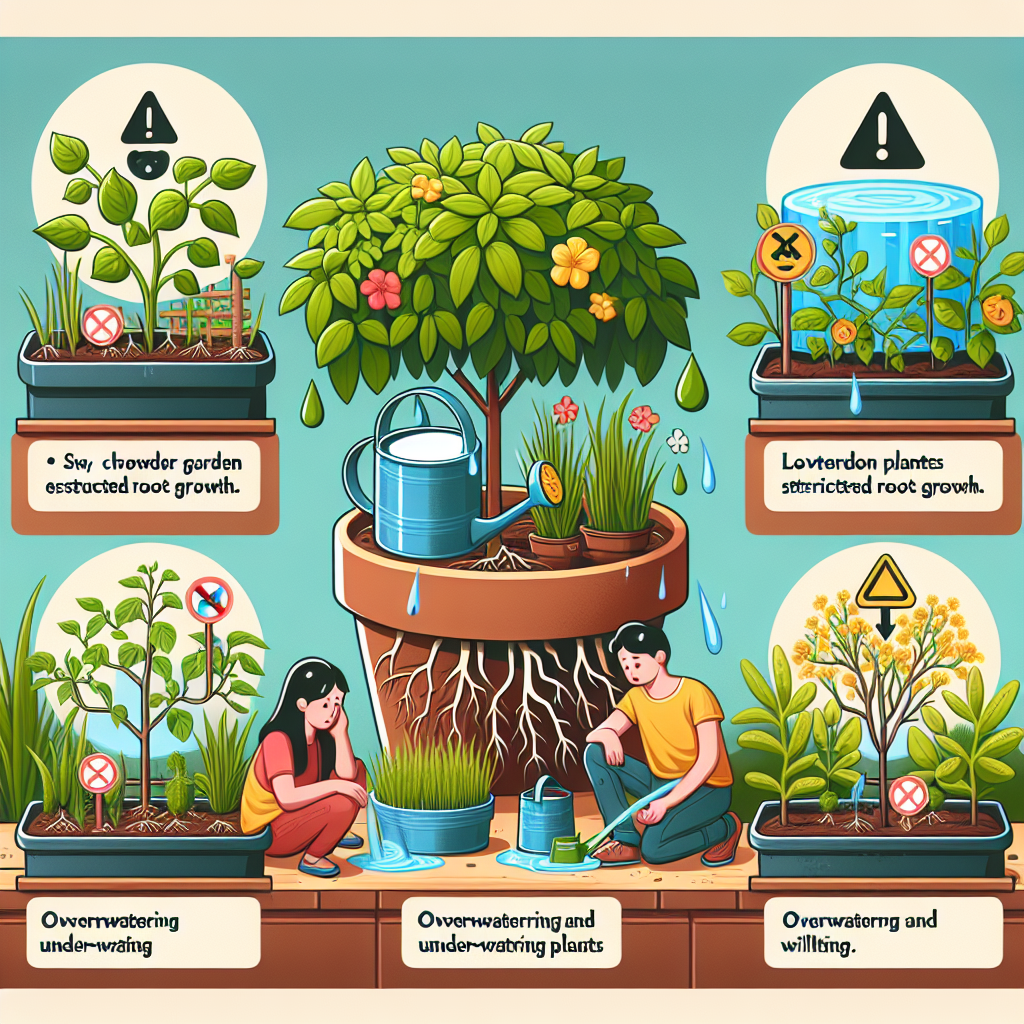
Container gardening can be a convenient and enjoyable way to cultivate plants in limited spaces, such as balconies or small yards. However, it’s important to be aware of the potential disadvantages that come with this gardening method. From restricted root growth to limited nutrient availability, container gardening poses certain challenges that can impact the overall health and productivity of your plants. In this article, we’ll explore some of the downsides of container gardening and provide tips on how to mitigate them, ensuring you can make the most out of your gardening experience.
Limited space
Restricts plant growth
When practicing container gardening, one of the main disadvantages is the limited space it provides for plant growth. Unlike traditional gardens where plants have the freedom to expand their roots as far as they need to, containers confine plants to a restricted area. This restriction can inhibit the overall growth and development of the plant, limiting its potential size and vitality.
Limits plant variety
Another drawback of container gardening is the limited range of plant varieties that can be grown. Due to the constraints of space and the specific needs of certain plants, not all types of plants are suitable for container gardening. Large, sprawling plants or those with deep root systems may struggle to thrive in containers, limiting the variety of plants that gardeners can cultivate.
Requires frequent repotting
Container gardening often requires gardeners to repot their plants regularly. As plants grow, their root systems need more space to continue flourishing. This means that containers must be continuously upgraded to accommodate the expanding roots. Frequent repotting can be a time-consuming and labor-intensive task, especially for gardeners with a large number of plants. Additionally, the cost of purchasing new containers and potting mix can add up, impacting the overall expense of container gardening.
Root restriction
Stunts plant growth
One of the major challenges of container gardening is the restriction it places on root growth. Plants rely on a healthy root system to absorb nutrients and water from the surrounding soil. However, in containers, the limited space confines the roots and can stunt their growth. As a result, the overall growth of the plant may be compromised, leading to smaller or less robust plants compared to those grown in the ground.
Increases susceptibility to disease
When roots are confined to a small container, they can become more susceptible to diseases and infections. The restricted space can create a conducive environment for the growth of pathogens, making plants more prone to infections. Additionally, the lack of natural soil organisms that contribute to plant health in traditional gardening further increases the risk of disease transmission in container gardening.
Requires careful watering
Watering plants in containers can be a delicate balancing act. The limited soil volume in containers means that water retention is reduced, making it challenging to provide plants with adequate hydration. Overwatering can lead to root rot and other moisture-related issues, while underwatering can result in dehydration and damage to the plant. Gardeners must be vigilant and mindful of their watering practices to ensure the optimal health and growth of container-grown plants.

Moisture management
Watering challenges
Container gardening presents unique challenges when it comes to watering. Unlike established gardens where the soil’s moisture levels are more stable, containers can quickly dry out, requiring frequent watering. This demand for consistent moisture management can be time-consuming, especially during hot and dry weather conditions. Additionally, when plants are overcrowded in containers, it becomes even more difficult to ensure adequate water distribution to each plant.
Increased risk of root rot
Overwatering or poor drainage in containers can lead to excess moisture being trapped around the roots, increasing the risk of root rot. Root rot occurs when the roots are continuously exposed to excess moisture, causing them to become waterlogged and susceptible to fungal infections. This condition can be detrimental to the health of plants and may even lead to their eventual demise if not addressed promptly.
Need for careful monitoring
Moisture levels in containers need to be monitored closely to ensure plants receive the right amount of water. Unlike in-ground gardens where plants can access water from a larger soil reservoir, containers have limited water-holding capacity. This requires gardeners to be diligent in monitoring and adjusting their watering practices to avoid under or overwatering, providing the necessary moisture for optimal plant growth.
Nutrient deficiencies
Limited nutrient availability
Container gardening tends to have limited nutrient availability compared to growing plants directly in the ground. The confined space of containers restricts the amount of soil organic matter that can be present, reducing the natural nutrient content available to plants. This limitation can lead to nutrient deficiencies, negatively impacting the growth and vitality of container-grown plants.
Leaching of nutrients
When watering container plants, excess water can cause nutrients to leach out of the container. Unlike gardens where nutrients are absorbed and held in the soil, container gardens lack a large volume of soil to retain and cycle nutrients. This leaching effect can result in the loss of essential plant nutrients, requiring gardeners to provide regular fertilization to replenish the nutrient levels in the container’s soil.
Regular fertilization required
Given the limited availability and leaching of nutrients, container gardening necessitates regular fertilization to ensure plants receive adequate nutrition. Gardeners must provide a balanced and appropriate fertilizer regime to prevent nutrient deficiencies and promote healthy plant growth. Failure to maintain proper fertilization can result in weakened plants that are more susceptible to diseases and pest infestations.

Temperature fluctuations
Less insulation for roots
One of the challenges container-grown plants face is the lack of insulation for their roots. The walls of containers do not provide the same insulation as the surrounding soil in in-ground gardens. As a result, the roots of container plants may be more exposed to extreme temperature fluctuations, which can have a detrimental impact on their overall health and growth.
Greater susceptibility to temperature swings
Container gardening poses a higher risk for plants when it comes to temperature swings. The restricted soil volume in containers cannot buffer temperature changes as effectively as the expansive soil in traditional gardens. This can lead to plants experiencing more significant fluctuations in temperature, which can stress them and compromise their growth. Certain plants may struggle to adapt to sudden temperature shifts, further limiting the variety of plants suitable for container gardening.
Additional protection needed
To mitigate the negative effects of temperature fluctuations, container gardens may require additional protection. Gardeners may need to provide insulation for the pots or move the containers to more sheltered locations during extreme weather conditions. Taking proactive measures can help safeguard the plants from the harmful impacts of temperature swings and ensure their long-term well-being.
Pest and disease susceptibility
Greater vulnerability to pests
Container-grown plants can encounter an increased vulnerability to pests compared to those in traditional gardens. The restricted space of containers can attract a higher concentration of pests, making it easier for them to infest plants. Additionally, pests may find it more challenging to disperse from containers, allowing infestations to proliferate more rapidly and cause significant damage.
Higher risk of disease transmission
Container gardening also presents a higher risk of disease transmission. The limited soil volume and lack of natural soil organisms that contribute to disease suppression in traditional gardens make container plants more susceptible to various plant diseases. If one plant becomes infected, the close proximity of other container plants can facilitate the spread of the disease, putting the entire garden at risk.
Increased need for pest control
Given the heightened vulnerability to pests and diseases, container gardeners must be proactive in implementing effective pest control measures. Regular monitoring and early detection of pest infestations are crucial to prevent the rapid spread of pests throughout the garden. The use of organic or chemical-based pest control methods may be necessary to manage pest populations and protect the health and vitality of container-grown plants.

Weed management
Greater weed growth
Contrary to popular belief, container gardens are not immune to the challenge of weed growth. Weeds can invade containers through wind dispersal or by hitching a ride on animals, clothing, or other gardening tools. However, due to the restricted space and limited soil volume, the presence of weeds can have a more significant impact in container gardening. Weeds compete with container plants for vital resources, such as water and nutrients, leading to decreased vigor and growth.
Difficult to remove weeds from containers
Removing weeds from containers can be a more challenging task compared to removing them from traditional gardens. The constrained space and the intertwined roots of container-grown plants can make it difficult to extract weeds without causing damage to the desirable plants. Gardeners must exercise care and precision during weed removal to minimize the risk of harming the plants they aim to nurture.
Regular weeding required
To maintain the health and productivity of container gardens, regular weeding is necessary. By proactively removing weeds, gardeners can prevent competition for resources and ensure that their desired plants receive the necessary nutrients and water. Frequent weeding sessions may be required to keep the container garden free from invasive weeds, requiring time and effort from the gardener.
Limited soil volume
Reduced nutrient-holding capacity
One of the limitations of container gardening is the reduced nutrient-holding capacity of the soil. Compared to traditional gardens, containers can only accommodate a limited amount of soil, which restricts the availability of essential nutrients for plant uptake. As a result, container-grown plants may be more prone to nutrient deficiencies, requiring regular fertilization to compensate for the decreased nutrient reservoir.
Decreased water retention
Container gardens also struggle with decreased water retention due to the limited soil volume. The smaller amount of soil available in containers cannot retain water as effectively compared to expansive garden beds. As a result, container-grown plants may require more frequent watering to ensure they receive adequate hydration. The need for regular and mindful watering can be time-consuming for gardeners, especially when managing multiple containers.
Frequent soil replacement necessary
Due to the limited soil volume and decreased nutrient-holding capacity, container gardens may require more frequent soil replacement to maintain optimal plant health. Over time, the soil in containers can become depleted, resulting in nutrient deficiencies and reduced plant vigor. To ensure the continuous growth and well-being of plants, gardeners should periodically replace the soil in containers with fresh, nutrient-rich potting mix.

Structural stability
Containers can tip over
One of the factors to consider in container gardening is the potential for containers to tip over. While it may seem like a minor concern, weather conditions, uneven ground, or accidental contact can cause containers to become unstable and topple. This can result in damage to both the plants and the containers, disrupting the overall aesthetic and functionality of the garden.
Risk of damage to plants
The instability of containers also puts plants at risk of physical damage. When containers tip over, plants may experience broken stems, damaged leaves, or dislodged root systems, impairing their ability to thrive. Additionally, the sudden jolt from a fallen container can disturb the delicate balance between the plant’s roots and its surrounding environment, leading to stress or even plant death.
Requires careful placement
To minimize the risk of containers tipping over, gardeners need to carefully consider the placement of their containers. Placing containers on stable and level surfaces, such as sturdy plant stands or levelled ground, can help prevent accidents and ensure the structural stability of the garden. gardeners should also be mindful of potential hazards that could inadvertently cause containers to become unstable.
Higher cost
Expense of containers
Container gardening can incur additional costs compared to traditional gardening methods. The purchase of suitable containers that provide adequate space for plant growth can be a significant investment. Depending on the desired aesthetic and the specific needs of plants, gardeners may need to buy various types and sizes of containers, adding to the overall expense of the garden.
Need for quality potting mix
In addition to containers, gardeners must invest in high-quality potting mix to provide the necessary nutrients and moisture for container-grown plants. While it is possible to make homemade potting mixes, many gardeners opt to purchase commercially available mixes for their convenience and consistent quality. The cost of continuously replenishing the potting mix can contribute to the higher expenses associated with container gardening.
Additional costs for watering and fertilizers
Container gardens may require increased use of resources such as water and fertilizers. Containers tend to have more frequent water requirements due to their limited soil volume and decreased water retention capacity. This increased need for watering can lead to higher water bills or increased water usage. Additionally, the necessity for regular fertilization to ensure adequate nutrient levels in the container garden adds to the overall cost of maintaining a thriving container garden.
In conclusion, while container gardening offers many advantages such as versatility and accessibility, it is essential to be aware of the potential drawbacks. The limited space, root restriction, moisture management challenges, nutrient deficiencies, temperature fluctuations, pest and disease susceptibility, weed management, limited soil volume, structural instability, and higher cost are factors that should be considered when deciding whether container gardening is the right choice for you. With careful planning, thoughtful care, and proper understanding of these limitations, gardeners can still create and enjoy beautiful container gardens that thrive despite the challenges they may face.






